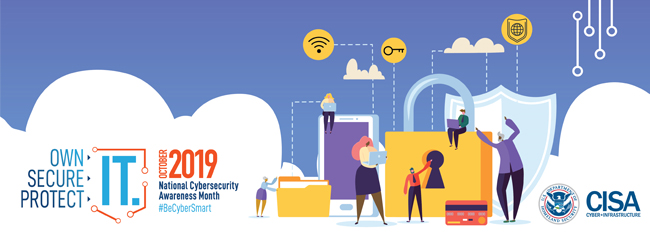Written by Guy McAllister, Director, Privacy & Security - iatricSystems

We just wrapped up the month of October supporting National Cybersecurity Awareness Month and the emphasis focused on the mantras of Own IT, Secure IT, Protect IT as it relates to your personal and patient data. As a leader in Patient Privacy, we were proud to participate in National Cybersecurity Awareness month, and share many educational resources throughout the month. Each week during the month we focused on a different topic to give you tips for what hospital leaders (and in some cases, you personally) can do to improve cybersecurity protection.
I am going to recap the activities from Cybersecurity Awareness Month here. Each "Week" heading below will link to the original blog post, and under each topic will be a link to the 10-minute informative webinar recording that we presented for each topic.
We kicked off the week talking about what can be done to protect the data you own while maintaining the remote access for you, your vendors and your employees.
Some key takeaways to protect remote access to your hospital network include:
Watch the Remote Access Security recording below. The webinar talks a little more in depth about steps that you can take to secure remote access to your network.
{% video_player "embed_player" overrideable=False, type='scriptV4', hide_playlist=True, viral_sharing=False, embed_button=False, width='1920', height='1080', player_id='19685002721', style='' %}
Watch "The Importance of Multi-Factor Authentication" below to learn how having MFA can be helpful in meeting your cybersecurity goals.
{% video_player "embed_player" overrideable=False, type='scriptV4', hide_playlist=True, viral_sharing=False, embed_button=False, width='1920', height='1080', player_id='19685007593', style='' %}
We went into detail about what constitutes a breach and what you can do to make sure that you are complying with the HIPAA requirements.
Watch the "Cost of Violating HIPAA" webinar recording below see how prepared you are in meeting HIPAA requirements.
Phishing attacks are one of the most common ways that hackers get access to your network. There are three types of Phishing:
Watch "What You Need to Know about Phishing Attacks" below and learn how to protect your organization from scammers!
{% video_player "embed_player" overrideable=False, type='scriptV4', hide_playlist=True, viral_sharing=False, embed_button=False, width='1920', height='1080', player_id='19790639338', style='' %}
We go into detail about the layered model of patient privacy that is outlined in HIPAA. This includes the following layers:
{% video_player "embed_player" overrideable=False, type='scriptV4', hide_playlist=True, viral_sharing=False, embed_button=False, width='1920', height='1080', player_id='19897952721', style='' %}
We hope that you found the information from our Cybersecurity Awareness month informative and helpful in your cybersecurity journey. Click here to access all of the on-demand cybersecurity 10-minute webinars in one place.